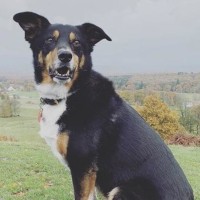 |
Doberman Collie |
|
He is not recognized by the F.C.I. |
Origin |
Germany <> Great-Britain -> U.S.A. | |
Translation |
Francis Vandersteen |
A brief presentation of the Doberman Collie |
| The Doberman Collie is described as an alert, agile and very active mix of the Dobermann and Border Collie. It will be a medium to large dog with a sense of adventure and strong loyalty to its family. Athletic and intelligent, he'll love to work. His parents were working dogs, excelling in guarding and breeding, your hybrid will also love to work but will always be ready to snuggle up with his family at the end of the day. This dog will need an owner with the energy to keep up. |
History of the Doberman Collie |
| Your hybrid's history book hasn't been written yet, but we can turn to its parent breeds. |
A little of the Dobermann |
||
| The Dobermann is a German breed, developed in 1890 by Karl Friedrich Louis Dobermann. He was a tax collector looking for a companion who could offer protection and perhaps a little intimidation while he made his rounds. Later, Dobermanns continued to offer protection and were brave companions in war, working as sentries, scouts and messengers. This breed is said to have ancestors such as the Weimar Pointer, the Rottweiler, the German Pinscher, the Beauceron and even the Manchester Terrier. In fact, several breeds were combined by Mr. Dobermann as he perfected the breed. | ||
 |
||
| Standard of the Dobermann | ||
A little of the Border Collie |
||
| Created before 1800, Thomas Beckwick's wood carvings in The History of Quadrupeds show dogs resembling the Border Collie. A variety of sheepdogs were found in Britain in the 1800s, each with its own breeding style. The first documented attempt at a sheepdog was in 1873, when a dog named Hemp performed exceptionally well. Hemp is thought to be the father of the Border Collie breed. Some believe the Border Collie is a descendant of older British driving dogs with a mix of Spaniels. Queen Victoria is said to have been taken with the breed when she first saw a Border Collie on a trip to Balmoral. In 1906, the first breed standard was developed, although the breed was known as a "sheepdog" until around 1915, when the name Border Collie was first used. It's likely that the name refers to the breed's origin, the area between the Scottish and English borders. When introduced to the United States, the breed was popular among shepherds and became well known for its success in obedience trials. Dogs of the breed have also been successfully trained as guide dogs for the blind. The Border Collie was recognized in 1995 by the American Kennel Club. | ||
 |
||
| Standard of the Border Collie |
Appearance of the Doberman Collie |
| The Doberman Collie will be a strong, athletic dog with a long body, although size varies according to parental influences. Its feet will have strong pads and nails, and its legs will be muscular. Your hybrid may have the facial shape of either parent; both have long muzzles, although the Dobermann parent has a narrower look. Your Doberman Collie will have bright eyes, a powerful jaw and well-developed teeth. His ears may be semi-erect or slightly upturned. His coloring can easily reflect both parental influences, he may have the white Border Collie patches on his chest, or may be predominantly beige and black. Interestingly, his coat can vary from short and smooth to medium and rough. |
Temperament of the Doberman Collie |
| The Doberman Collie is known to be reserved with strangers. To enable your hybrid to become comfortable in all situations, socializing with people is a must. What's more, although he's generally friendly with dogs, he can have problems with dogs of the same sex, making trips to the dog park necessary for many interactions. Starting at a young age will be ideal. Perceptive and highly intelligent, he should be easy to train and thrive on praise. This hybrid is not for those who don't have the time to work with him, or for homes where he will be left alone for long periods. He needs to be kept busy and have company, or he may resort to destroying property due to anxiety and boredom. |
Needs and activities of the Doberman Collie |
| The Doberman Collie has lots of energy, both physically and mentally, and loves to have a job to do. He'll love the thrill of a breeding or obedience trial. A dog who loves to run, he'll make an excellent jogging partner. Doberman Collie owners say this is the type of dog that will help you stay in shape. Their attitude and energy levels demand an owner willing to commit to a minimum of 60 minutes a day, more would be even better. |
Maintenance of the Doberman Collie |
| If your Doberman Collie inherits a longer coat, it will need regular grooming, including weekly combing and brushing, with extra time needed during periods when its undercoat is shedding. Bathing should only take place when necessary, although his ears and coat should be checked regularly for ticks if he is often active outdoors. This hybrid loves to run, and if you take him to places with long grass, he may encounter ticks. An apartment is not an ideal living situation for a Doberman Collie, nor should he be chained in a yard for long periods. He's a people dog and also a dog who needs a job to keep him happy. |






 English (United Kingdom)
English (United Kingdom)